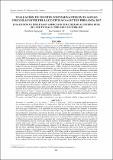Por favor, use este identificador para citar o enlazar este ítem:
https://hdl.handle.net/20.500.12958/6544| Título : | Evaluación de fuentes contaminantes en el anillo circunlacustre del lago Titicaca (sector peruano), 2017 |
| Otros títulos : | Evaluation of pollutant sources in the circumlacustrine ring of Lake Titicaca (Peruvian sector), 2017 |
| Autor : | Siguayro, Humberto Pasapera, José Villanueva, Carmen Coila, Yanet Gamarra, Cesar |
| Palabras clave : | Lago Titicaca;Carga contaminante;Ríos;Aguas residuales;Calidad de agua;Estado trófico |
| Fecha de publicación : | dic-2022 |
| Editorial : | Instituto del Mar del Perú |
| Citación : | Siguayro, H., Pasapera, J.(), Villanueva, C., Coila, Y., Gamarra, C. (2022). Evaluación de fuentes contaminantes en el anillo circunlacustre del lago Titicaca (sector peruano), 2017. Bol Inst Mar Perú. 37(2): 361-386. |
| Citación : | Boletín IMARPE 37(2), 2022; |
| Resumen : | El Lago Titicaca con aportes fluviales (tributarios) considerado endorreico, es un ecosistema que desempeña diferentes funciones y acoge gran biodiversidad. De ahí la importancia de efectuar la evaluación de contaminantes, especialmente la adición de nutrientes, para valorar las fuentes contaminantes en el anillo circunlacustre del lago mediante la exploración de parámetros fisicoquímicos, considerando estado de la calidad del agua, aporte de la carga contaminante y variabilidad entre zonas y periodos evaluados. Se realizaron campañas en abril y setiembre/
octubre 2017. Las estaciones de monitoreo estuvieron en zonas de afluencia de la red tributaria que desagua en el lago y en puntos de ingreso de efluentes que captan aguas residuales. Se consideraron 39 estaciones (20 en bahías y desembocaduras de ríos, 10 en afluentes de ríos y 9 en puntos efluentes de aguas residuales de las plantas de tratamiento de aguas residuales - PTAR). Las descargas de aguas residuales presentaron rangos elevados de demanda bioquímica de oxígeno - DBO5, nitrógeno y fósforo total, excediendo los límites máximos permisibles. Coliformes termotolerantes en todos los efluentes, excepto la laguna de oxidación de Tilali, no mostraron diferencias significativas (p> 0,05) entre periodos de evaluación. Referente a evaluación de ríos, se observó que la descarga diaria con mayor contribución de contaminantes se presentó en abril (nitrógeno total 15,70 t/día, fósforo total 3,54 t/día, SST 921,69 t/día y DBO5 42,02 t/día), en setiembre/octubre se redujo, los mayores aportes se registraron en la confluencia de los ríos Ramis y Huancané, Coata e Ilave. En comparación con lo reportado el 1981-1982, el nitrógeno total se incrementó a 0,65 y el fósforo total a 0,94. Respecto a la evaluación de calidad de agua según ECAs categoría 3 para ríos, excedió el pH en todas las estaciones evaluadas, la DBO5 superó para el Coata y los coliformes termotolerantes fueron altos para el río Desaguadero. En relación con bahías y zonas de desembocaduras del lago Titicaca (sector peruano), los nutrientes presentaron valores altos en la bahía de Puno y Yunguyo. Según ECA – categoría 2 y 4, en la mayoría de las zonas evaluadas, estuvieron altos conductividad eléctrica, fósforo y nitrógeno totales. En la bahía interior de Puno y Yunguyo se encontraron por encima de los rangos permisibles la clorofila-a, DBO5, SST y coliformes termotolerantes, presentando niveles hipertróficos. Según el análisis estadístico no mostró diferencias significativas (p>0,05) entre periodos evaluados. ABSTRACT: Lake Titicaca with river contributions (tributaries) considered endorheic, is an ecosystem that plays different functions and hosts great biodiversity. It is important to evaluate pollutants, especially the addition of nutrients, to evaluate the pollutant sources in the circumlacustrine ring of Lake Titicaca through the exploration of physicochemical parameters, considering the state of water quality, the contribution of the pollutant load, and variability between areas and periods evaluated. In April and September/October 2017, two campaigns were carried out and the monitoring stations were in areas where the tributary inflow drains into the lake, and at effluent entry points that capture wastewater. We considered 39 stations (20 in bays and river mouths, 10 in river tributaries, and 9 in wastewater effluent points of treatment plants - WWTPs). Wastewater discharges yielded high levels of BOD5, nitrogen, and total phosphorus, exceeding the maximum permissible limits (D.S. 003-2010-MINAM) for thermotolerant coliforms in all effluents, except for the Tilali oxidation pond, did not show significant differences (p> 0.05) between evaluation periods. As for rivers, we observed that the daily discharge with the highest pollutant contribution occurred in April (total nitrogen 15.70 t/day, total phosphorus 3.54 t/day, TSS 921.69 t/day, and BOD5 42.02 t/day), while in September/October it was reduced, the greatest contributions were recorded at the confluence of the Ramis and Huancané, Coata and Ilave rivers. There was an increase of 0.65 (total nitrogen) and 0.94 (total phosphorus) compared to 1981-1982. According to the WQS category 3 for rivers, pH exceeded in all the zones evaluated, BOD5 was higher for the Coata River, and thermotolerant coliforms were high for the Desaguadero River. Regarding the bays and mouths of Lake Titicaca (Peruvian sector), nutrients showed high values in the bay of Puno and Yunguyo. According to WQS – category 2 and 4 (D.S. Nº 004-2017-MINAM), the electrical conductivity, total phosphorus, and total nitrogen were exceeded in most of the evaluated areas, while in the inner bay of Puno and Yunguyo, chlorophyll-a, BOD5, TSS were found above the permissible ranges, presenting hypertrophic levels according to the trophic status of the OECD (1982). No significant differences (p>0.05) were found between the periods evaluated, based on the statistical analysis. |
| URI : | https://hdl.handle.net/20.500.12958/6544 |
| ISSN : | 04587766 |
| Aparece en las colecciones: | Boletín 37(2) 2022 |
Ficheros en este ítem:
| Fichero | Descripción | Tamaño | Formato | |
|---|---|---|---|---|
| Boletin 37-2 artículo10.pdf | 1,73 MB | Adobe PDF |  Visualizar/Abrir |
Este ítem está sujeto a una licencia Creative Commons Licencia Creative Commons

